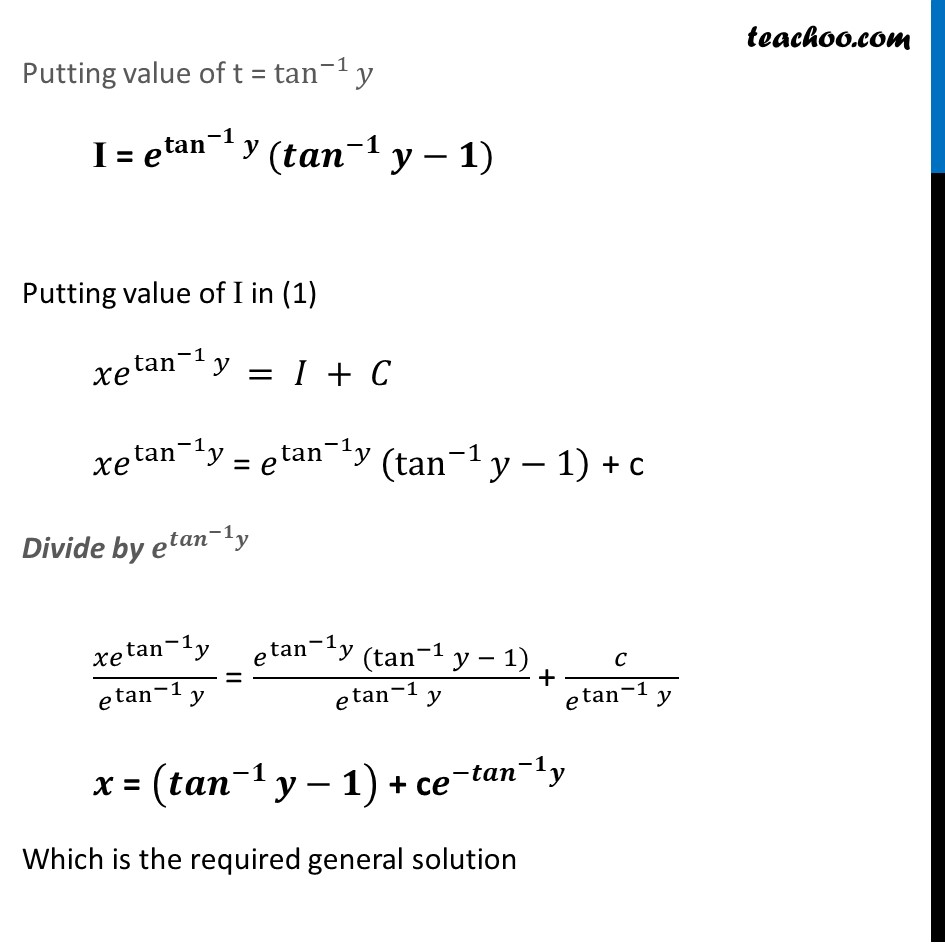






Examples
Last updated at April 16, 2024 by Teachoo







Example 22 (Introduction) Solve the differential equation 𝑑𝑥/𝑑𝑦+𝑥/(1+𝑦^2 )=tan^(−1)𝑦/(1+𝑦^2 ) 𝑑𝑥/𝑑𝑦+𝑥/(1 + 𝑦^2 )=tan^(−1)𝑦/(1 + 𝑦^2 ) 𝑑𝑥/𝑑𝑦=tan^(−1)𝑦/(1 + 𝑦^2 ) – 𝑥/(1 + 𝑦^2 ) 𝑑𝑥/𝑑𝑦=(tan^(−1)𝑦 − 𝑥)/(1 + 𝑦^2 ) 𝒅𝒚/𝒅𝒙 = ((𝟏 + 𝒚^𝟐))/〖𝒕𝒂𝒏〗^(−𝟏)〖𝒚 − 𝒙〗 The variables cannot be separated. So variable separable method is not possible Now, 𝑑𝑦/𝑑𝑥 = ((1 + 𝑦^2))/tan^(−1)〖𝑦−𝑥〗 Put F(x, y) = 𝒅𝒚/𝒅𝒙 F(x, y) = (1 + 𝑦^2)/(tan^(−1)𝑦−𝑥) F(𝜆x, 𝜆y) = (1 + 𝜆^2 𝑦^2)/(tan^(−1)𝜆𝑦−𝜆𝑥) F(𝜆x, 𝜆y) ≠ 𝜆° F(x, y) Hence, the equation is not homogenous. So we use the integrating factor method 𝑑𝑦/𝑑𝑥 = ((1 + 𝑦^2))/(tan^(−1) y − x) This is not of the form 𝒅𝒚/𝒅𝒙+𝑷𝒚=𝑸 ∴ We need to find 𝒅𝒙/𝒅𝒚 𝑑𝑥/𝑑𝑦 = (tan^(−1)𝑦 − 𝑥)/(1 + 𝑦^2 ) 𝑑𝑥/𝑑𝑦 = tan^(−1)𝑦/(1 + 𝑦^2 ) − 𝑥/(1 + 𝑦^2 ) 𝑑𝑥/𝑑𝑦 + 𝑥/(1 + 𝑦^2 ) − (tan^(−1)𝑦 )/(1 + 𝑦^2 ) Differential equation is of the form 𝒅𝒙/𝒅𝒚 + P1 x = Q1 Thus, we solve question by integrating factor method taking 𝒅𝒙/𝒅𝒚 Example 22 Solve the differential equation 𝑑𝑥/𝑑𝑦+𝑥/(1+𝑦^2 )=tan^(−1)𝑦/(1+𝑦^2 ) 𝑑𝑥/𝑑𝑦+𝑥/(1 + 𝑦^2 )=tan^(−1)𝑦/(1 + 𝑦^2 ) Differential equation is of the form 𝒅𝒙/𝒅𝒚 + P1 x = Q1 where P1 = 1/(1 + 𝑦^2 ) & Q1 = (tan^(−1)𝑦 )/(1 + 𝑦^2 ) Now, IF = 𝑒^∫1▒〖𝑃_1 𝑑𝑦〗 IF = 𝑒^∫1▒〖1/(1 + 𝑦^2 ) 𝑑𝑦〗 IF = 𝒆^〖𝒕𝒂𝒏〗^(−𝟏)𝒚 Solution is x (IF) = ∫1▒〖(𝑄×𝐼𝐹)𝑑𝑦+𝐶〗 x𝒆^〖𝒕𝒂𝒏〗^(−𝟏)𝒚 = ∫1▒〖〖𝒕𝒂𝒏〗^(−𝟏)𝒚/(𝟏 + 𝒚^𝟐 )×𝒆^〖𝒕𝒂𝒏〗^(−𝟏)𝒚 𝒅𝒚〗 + C Let I = ∫1▒〖tan^(−1)𝑦/(1 + 𝑦^2 )×𝑒^tan^(−1)𝑦 𝑑𝑦〗 Let 〖𝒕𝒂𝒏〗^(−𝟏)〖𝒚 〗= t 1/(1 + 𝑦^2 ) dy = dt Putting values of t & dt in I I = ∫1▒〖𝒕𝒆^𝒕 𝒅𝒕〗 Integrating by parts with ∫1▒〖𝑓(𝑡) 𝑔(𝑡) 𝑑𝑡=𝑓(𝑡) ∫1▒〖𝑔(𝑡) 𝑑𝑡 −∫1▒〖[𝑓^′ (𝑡) ∫1▒〖𝑔(𝑡) 𝑑𝑡] 𝑑𝑡〗〗〗〗 Take f (t) = t & g (t) = 𝑒^"t" I = t.∫1▒〖𝑒^𝑡 𝑑𝑡−∫1▒[1∫1▒〖𝑒^𝑡 𝑑𝑡〗] 𝑑𝑡〗 I = t𝑒^𝑡 − ∫1▒〖𝑒^𝑡 𝑑𝑡〗 I = t𝒆^𝒕 − 𝒆^𝒕 I = 𝑒^𝑡 (t − 1) Putting value of t = tan^(−1)𝑦 I = 𝒆^(〖𝐭𝐚𝐧〗^(−𝟏)𝒚 ) (〖𝒕𝒂𝒏〗^(−𝟏) 𝒚−𝟏) Putting value of I in (1) 〖𝑥𝑒〗^(tan^(−1)𝑦 ) = 𝐼 + 𝐶 〖𝑥𝑒〗^(tan^(−1) 𝑦 )= 𝑒^(tan^(−1) 𝑦 ) (tan^(−1)𝑦−1) + c Divide by 𝒆^(〖𝒕𝒂𝒏〗^(−𝟏) 𝒚 ) 〖𝑥𝑒〗^(tan^(−1) 𝑦 )/𝑒^tan^(−1)〖𝑦 〗 = (𝑒^(tan^(−1) 𝑦) (tan^(−1)𝑦 − 1))/𝑒^tan^(−1)〖𝑦 〗 + 𝑐/𝑒^tan^(−1)〖𝑦 〗 𝒙 = (〖𝒕𝒂𝒏〗^(−𝟏)𝒚−𝟏) + c𝒆^(−〖𝒕𝒂𝒏〗^(−𝟏) 𝒚 ) Which is the required general solution